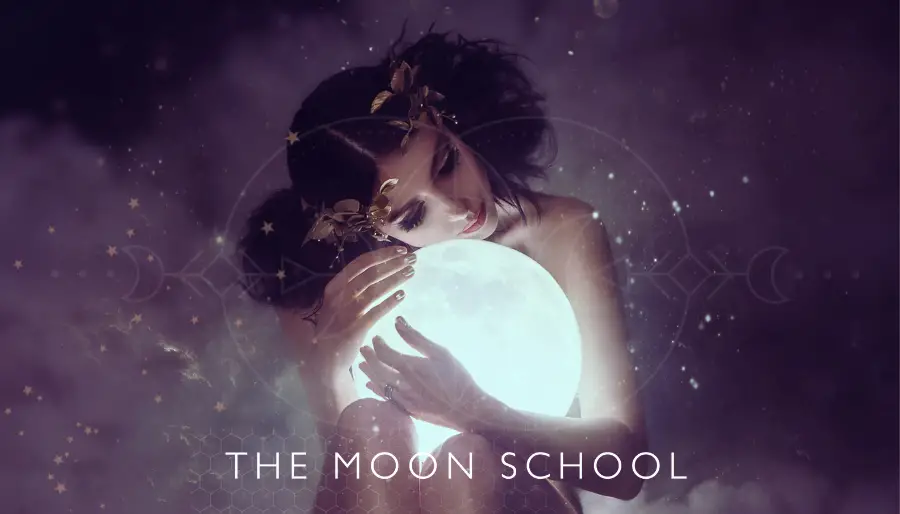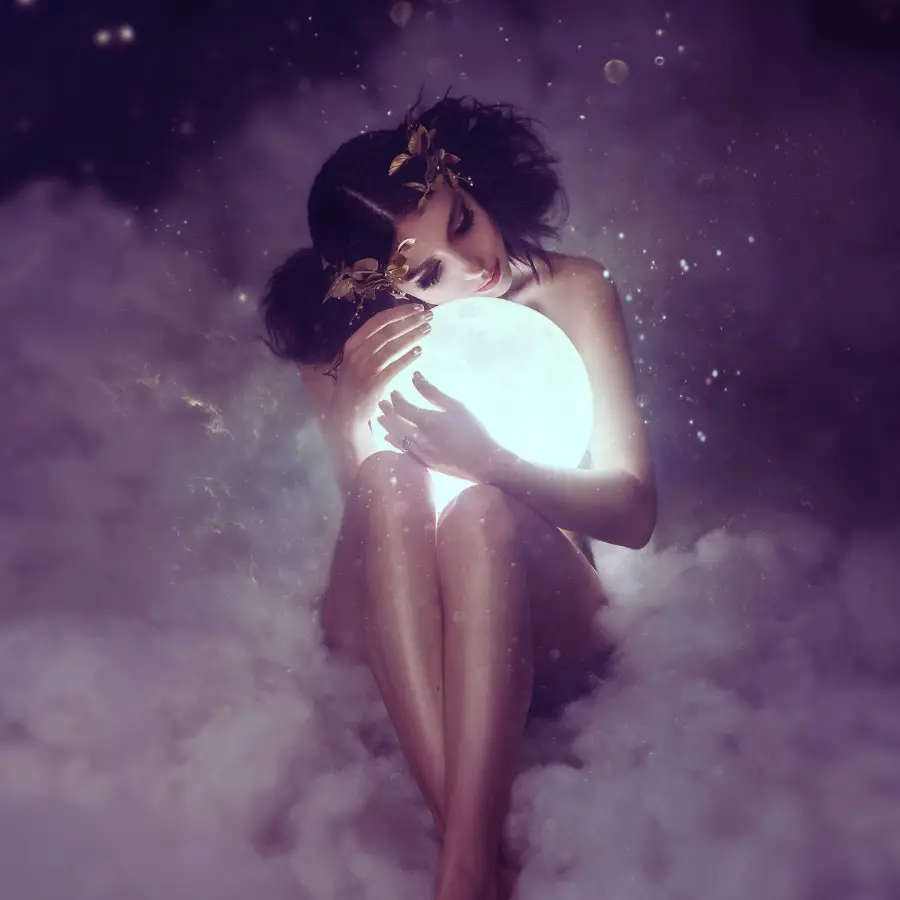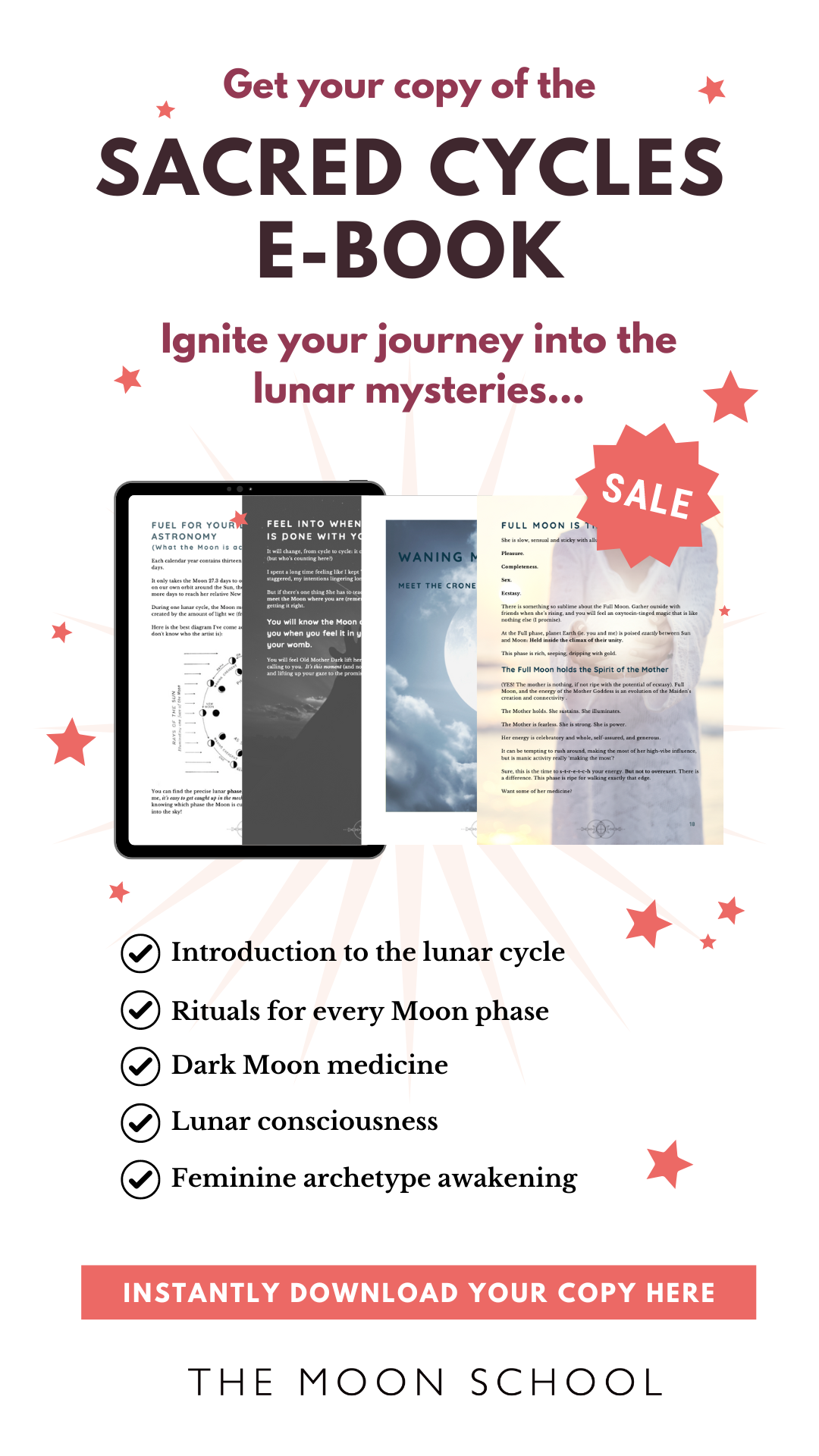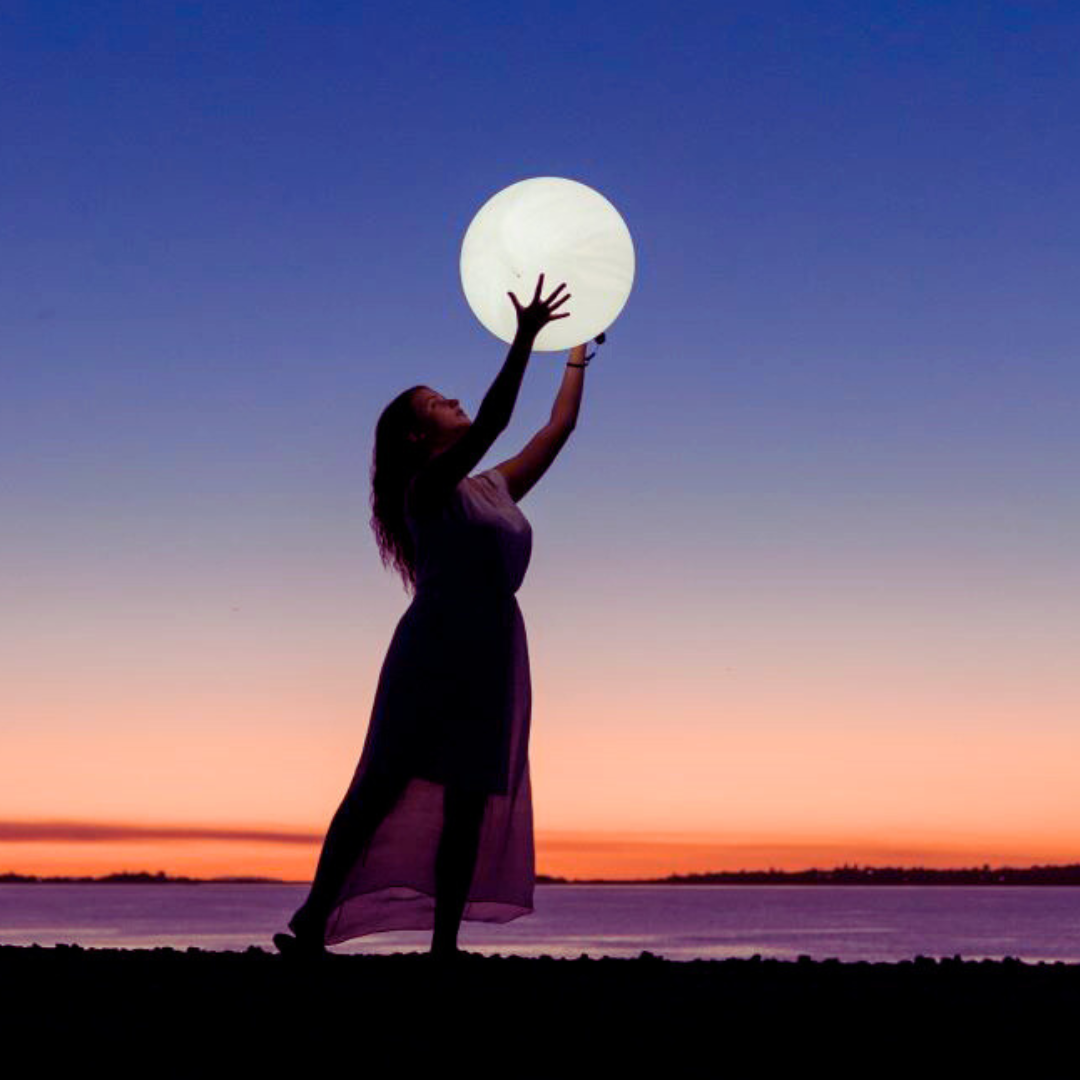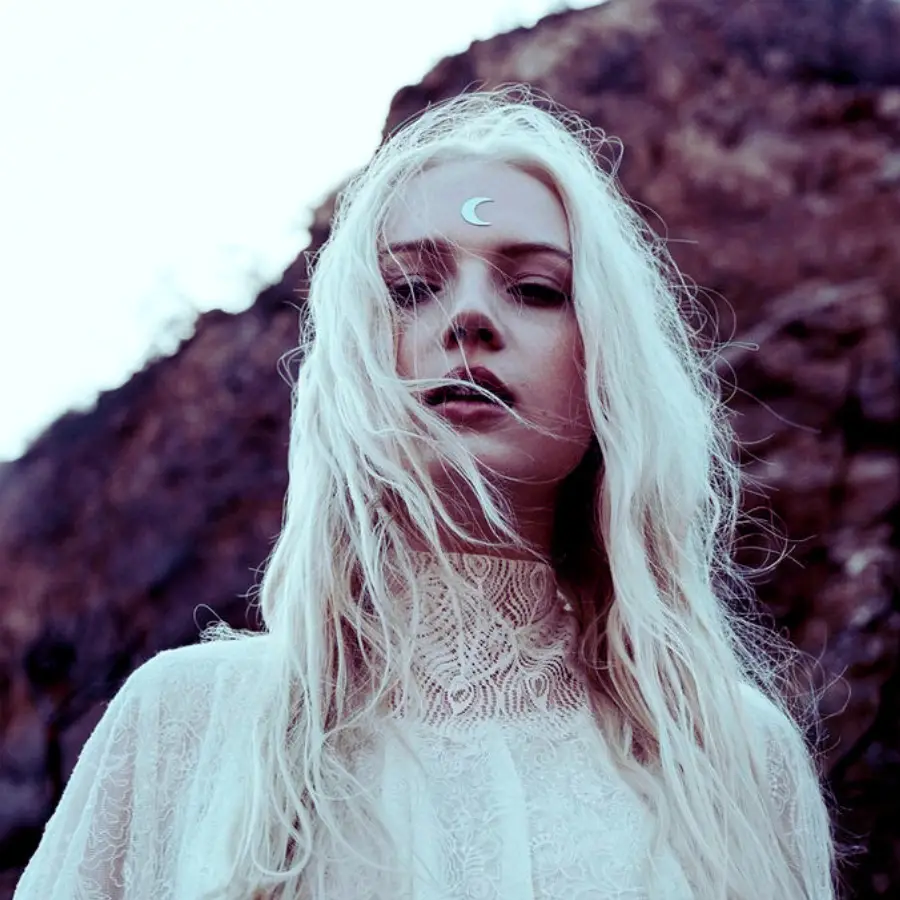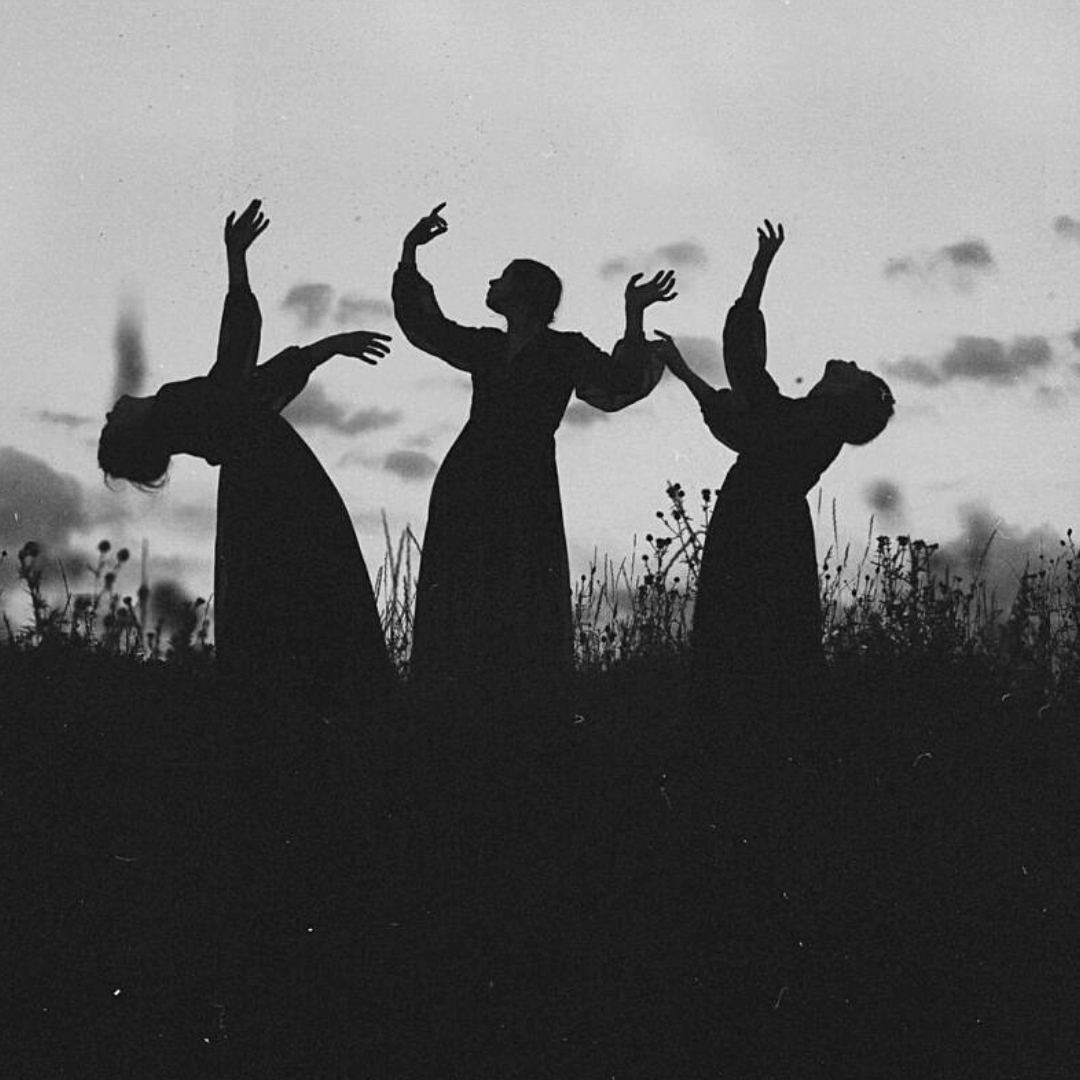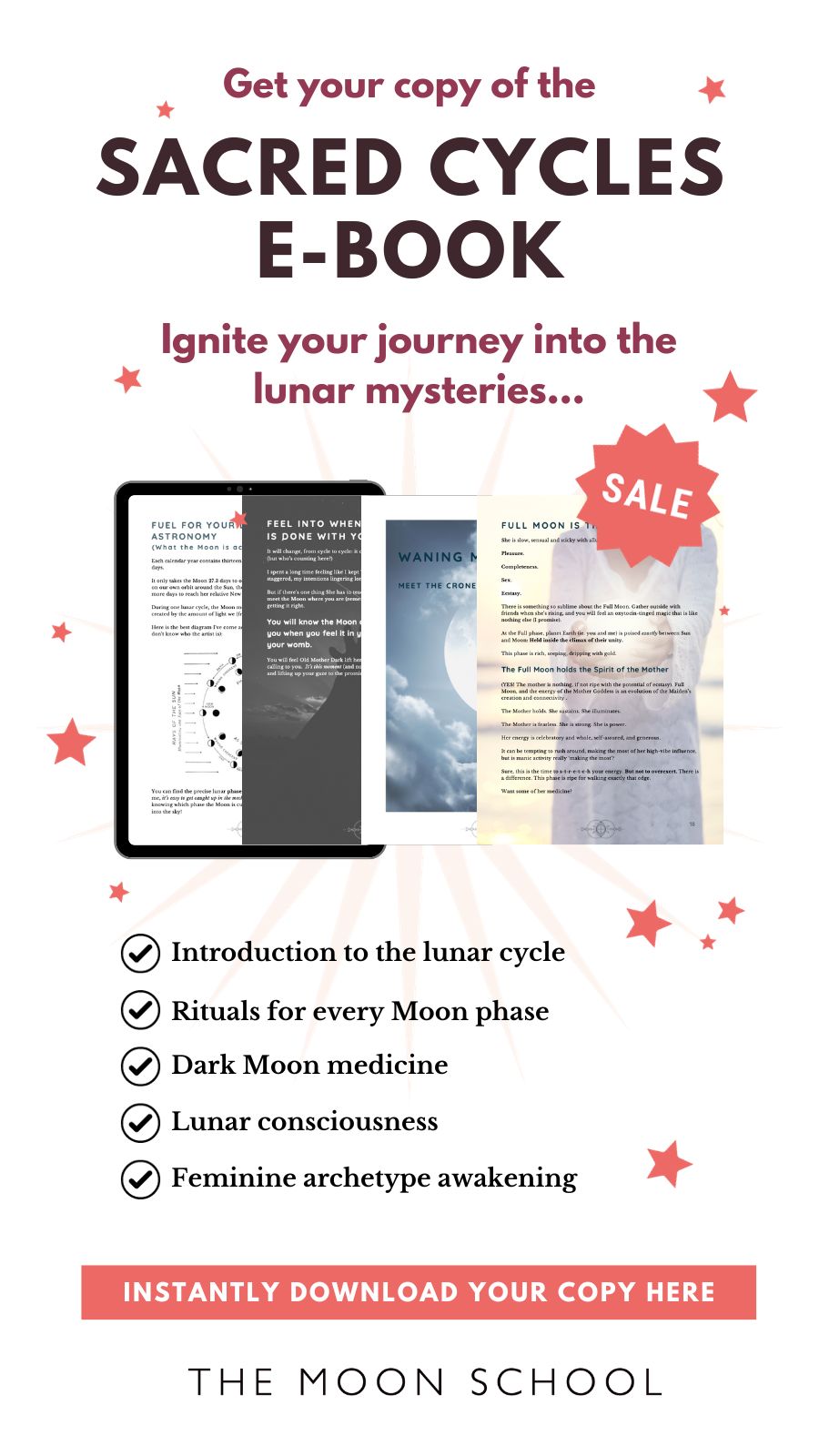In Greek mythology, the Moon was personified as Selene, a youthful goddess who represented the power and beauty of our lunar companion.
Today, Selene remains an important figure in mythology and continues to inspire artists, writers, mystics and scholars alike. Her story, symbols and associations remind us of the feminine power and mysteries of the Moon, and its ongoing significance in our lives.
Who is the Greek Goddess Selene?
Selene is the Greek goddess of the Moon. In ancient Greece she not only represented the Moon, she was its personification – alive, conscious, and an intrinsic part of life.
The word “Selene” is derived from the Greek noun selas, which means “light, brightness, gleam”.
In ancient Greek mythology, Selene was often depicted as a beautiful woman with a crescent moon on her forehead, riding a silver chariot drawn by two white horses across the night sky. She was believed to be responsible for the phases of the Moon, with the full Moon representing her at her most powerful.
Selene was also known for her love affairs with mortals, most notably with the handsome shepherd Endymion. According to the Homeric Hymns, Selene fell in love with Endymion and put him into an eternal sleep so she could visit him each night in his dreams.
Selene is a very beautiful lunar goddess, often described as “fair-tressed Selene”, “lovely Selene” or “lady Selene”. She is also known as the “immortal stainless queen,” reflecting her divine nature.
In Roman mythology, Selene’s roman counterpart is Luna, and the two goddesses share many similarities.
Are Selene and Luna the same?
Selene and Luna are similar in that they are both goddesses associated with the Moon, but they come from different mythologies. Simply: Selene is the Greek goddess of the Moon, while Luna is the Roman goddess of the Moon. Both are associated with our spinning, celestial orb and considered goddesses of light, but they have different origins and belong to different cultures.
What are the powers and strengths of Selene?
People worship the goddess Selene for many reasons. She’s predominantly known known as a Moon goddess, yet Selene has also been revered for having many more powers and strengths.
Fertility and childbirth
In Greek religion Selene was worshipped as a goddess of fertility and childbirth. The 29.5 day Moon cycle has always been intrinsically connected to the menstrual cycles of women, and therefore the mysteries of procreation. As well as being a lunar goddess, she is believed to have the power to promote growth and abundance.
The hunt
The Greek Moon goddess was also often associated with Artemis, who presided over the hunt.
Healing
The ancient Greeks believed Selene had the power to heal and restore balance to those who called upon her.
Beauty and grace
In Greek lyric poetry, Selene was often praised for her beauty and grace, and was considered a symbol of feminine power and mystique. Her myths and legends continue to inspire artists, writers, and poets to this day.
Change and cycles
Believed to have the power to control the tides of the ocean with her lunar cycles, Selene was, and is, known as a symbol of life’s constant changes and the natural rhythms and cycles that all life moves through.
Intuition and psychic abilities
As a greek goddess of the night, Selene is associated with the unseen realms, including dreams, intuition and psychic abilities.
Protection
Selene was one of the greek gods believed to offer protection to her worshippers, especially during times of darkness and uncertainty.
Selene’s family and siblings
Selene is a Titan goddess, meaning she was born of two of the original 12 Titans, a set of pre-Olympian greek deities.
According to Greek mythology, Selene is the grandaughter of Gaia and Uranus, and the daughter of the Titans Hyperion and Theia.
Hyperion was the Titan of light and was associated with the sun, while Theia was the Titaness of sight and was associated with shining metals and jewels.
Selene had two siblings:
Helios
Helios is the god of the sun and is Selene’s brother. He is often depicted driving a chariot across the sky, representing the movement of the sun.
Eos
Eos is the goddess of the dawn and is Selene’s sister. She is often depicted with rosy fingers, announcing the arrival of the sun.
Together, Selene, Helios, and Eos represent the cycle of day and night, and the movement of the sun and the Moon across the sky. They are all associated with light and are considered exceptionally powerful deities in Greek mythology.
What is the myth of Selene and Endymion?
The myth of Selene and Endymion is a story about the love between the Moon Goddess Selene and the mortal Endymion. Endymion was a shepherd, a hunter, or a king, depending on the version of the myth. Selene fell in love with Endymion and visited him every night as he slept.
According to the myth, Selene asked Zeus to grant Endymion everlasting youth and eternal sleep so that he could stay with her forever.
Zeus granted her wish, and the sleeping Endymion stayed forever in a cave on Mount Latmos.
In some versions, Selene bathes Endymion in the river before he falls asleep, while in others, she simply watches him in his eternal sleep.
The story of Selene and Endymion is a rare female pursuit in Greek mythology, with divine Selene being the one who actively pursues Endymion.
The myth has inspired many works of art throughout history, including paintings, sculptures, and poems.
The myth of Selene and Endymion has been interpreted in many different ways over the years. Some see it as a metaphor for the power of love, while others see it as a representation of the relationship between the moon and the earth.
Regardless, the story of Selene and Endymion remains a fascinating tale of love and devotion.
Moon Goddess Selene symbols and iconography
The Moon Goddess Selene has been depicted in countless forms of art and sculpture throughout history. Her iconography evolved over time, but some symbols remained consistent. Here are some of the most common representations of Selene:
Crescent Moon: Selene was often depicted with a crescent moon on her forehead or held in her hand. This symbolized the phases of the moon and her connection to it. The crescent moon is also associated with femininity and fertility.
Horned Selene: In some depictions, Selene was shown with horns on her head, which resemble the phases of the Moon. Also, as the moon waxes and wanes, it appears to grow and shrink, much like the horns of an animal.
Moon Incarnate: Selene was sometimes depicted as the moon itself, with a face on the lunar disk. This symbolized her close connection to the moon and her role as its personification.
Lunar Disk: The Moon goddess was often shown standing on a lunar disk, which represented the moon. This symbolized her dominion over the moon and her ability to control its movements.
Golden Diadem: Selene was sometimes depicted wearing a golden diadem, which symbolized her status as a Moon goddess and her connection to the heavens.
Moon Goddess Selene associations and symbols
As well as the unique and specific iconography attached to of the greek Moon goddess, there are other symbols associated with Selene. Here are a handful –
The Full Moon: The full moon is a symbol of Selene’s power and is often associated with her.
The Chariot: The goddess Selene is sometimes depicted riding a chariot across the sky, representing the movement of the Moon (see more below)
Horses: The chariot ridden by Moon Goddess Selene is pulled by two white horses, and sometimes these are regarded as symbols of her.
The Night Sky: Although the Moon can rise at any time of the day or night, our celestial orb is most often recognised nocturnally. So Selene the Moon deity is often associated with the night sky and with darkness.
Silver: As a symbol of the Moon’s light, Goddess of the Moon Selene is often associated with the colour silver. It’s also the colour of the chariot she pulled across the sky each night.
The Owl: Although most commonly connected to Athena, the owl is occasionally associated with The Goddess Selene as a symbol of the night.
The Stars: Again, as a greek goddess of the moon and the night, Selene is associated with the stars and is sometimes depicted surrounded by them.
The Sea: Believed to have the power to control the tides of the ocean, the beautiful moon goddess is also symbolised by the sea.
The lunar eclipse: The ancient Greeks saw lunar eclipses – when the Earth passes between the Sun and the Moon – as powerful omens. These were often associated with Selene’s wrath or displeasure.
Eternal Youth: Selene is believed to have granted eternal youth to her mortal lover, the sleeping Endymion. For this reason, she is sometimes regarded as a symbol of youthfulness and vitality.
The most well known symbol of the Goddess Selene: Her Moon chariot
Selene’s chariot is a well-known symbol of this beautiful goddess of the Moon. According to Greek mythology, Selene would ride her Moon chariot across the sky every night, from east to west, following her brother Helios, the sun god.
The Moon chariot was made of silver, pulled by two white horse, and was said to be a powerful and awe-inspiring sight, visible to all who looked up at the night sky. As it traveled across the heavens it cast a silvery light over the world below.
Selene’s chariot was seen as a physical representation of her power and influence. Its movement across the sky was a reminder of the passage of time and the inevitability of change.
In addition to its symbolic significance, Selene’s chariot had practical applications. The ancient Greeks (and Romans) used the phases of the Moon to mark the passage of time, as well as a tool to help guide travellers and sailors navigate in the dark.
Hecate and Artemis: 2 Goddesses associated with Selene
Selene is often associated with several other goddesses, primarily those who are also symbolically connected to the Moon, the night, and feminine energy and power. Here are a few examples:
Goddess Hecate
Hecate is the goddess of witchcraft, magic, and the night. As a dark Goddess, she is one of the oldest crone goddesses we know of. She is often associated with the waning Moon phases, and is sometimes depicted holding torches or keys – symbols of her power over the night.
Is Hecate Calling?
Read this post next: An Introduction to Hecate, Queen of Witches
Artemis
Artemis is the greek goddess of the hunt, the Moon, and childbirth. She is often associated with the waxing Moon and is sometimes depicted with a crescent moon on her forehead, similar to Selene.
Artemis tends to represent the wild woman, or huntress archetype. And she sometimes also appears as a maiden goddess.
Is Artemis Calling?
Read this post next: How to Invoke the Goddess Artemis
Is Selene a triple Goddess?
Her association with Artemis and Hecate means that the greek goddess Selene is often regarded as a triple goddess.
The triple goddess (represented by the triple Moon symbol) is a deity archetype that represents the phases of a woman’s life.
The triple Goddess is believed to be ancient, yet it’s become adopted by many modern pagans and Wiccans as an access point to explore the mysteries of the divine feminine.
What are some modern interpretations of Selene’s mythology and symbolism?
In many cultures of the past, the beautiful Moon goddess Selene was considered a divine being who watched over the world at night.
People would offer prayers and sacrifices to her, hoping for her protection and blessings.
Many believed that Selene had the power to influence the tides, the weather, and even human emotions.
The full moon was when bright Selene was at her fullest. This was a particularly important time for worship and celebration.
At this lunar phase, many festivals were held in ancient Greece, in honour of Selene, with offerings of food, drink, and flowers.
People would gather together to dance, sing, and celebrate the beauty and power of the Moon.
So it’s no surprise that the titan Goddess Selene is STILL popular today. She is revered, worshiped and honoured in our modern world too, though her relevance has adapted as we have.
Here are a few of her modern symbolic interpretations –
Selene as a symbol of feminine power
In modern times, Moon Goddess Selene is often seen as a symbol of feminine power. Her association with the changing lunar phases connect her intimately to the menstrual cycles of women, and to the changing phases of life. Her presence elevates these cycles to something sacred, profound, and other worldly.
Selene as a symbol of personal growth
Selene’s mythology and symbolism can be interpreted as a representation of personal growth and transformation. Again, the Moon goddess appears as a reminder of the importance of embracing change and transformation in our own lives.
Selene as a symbol of healing
The Moon continues to ebb and flow, continuing to rejuvenate with each cycle. Selene’s association with the process of healing and restoration represents the power of self-care and self-healing in our modern world.
Harnessing her energy and power, she can be called upon to promote healing and balance in the body and mind.
Selene as a symbol of intuition, dreams and psychic abilities
Selene’s association with the night makes her a mistress of dreams, intuition and psychic abilities. For some, the Moon goddess is a representation of the power of our inner wisdom and intuition. She can be called upon to enhance these abilities and tap into our own inner guidance.
Selene as a symbol of creativity
The power of the Moon Goddess Selene can also be interpreted as a force of creativity and imagination. Some followers tap into her energy and power to access their own creative potential and inspire new ideas and projects.
Do you want to work with the Moon Goddess Selene?
Read this post next – 20 BEST Ways to Work With Selene
Comparing Selene with other Moon goddesses
Selene shares similarities and differences with other lunar goddesses from different cultures and mythologies.
Here are a few examples:
Luna (Roman mythology)
Luna is the Roman goddess of the Moon, and is often associated with Selene. Like Selene, Luna is associated with the Moon and the night, and is often depicted with a crescent Moon on her forehead.
Chang’e (Chinese mythology)
Chang’e is the Chinese goddess of the moon, and is often associated with the Mid-Autumn Festival. Unlike Selene, Chang’e is believed to live on the Moon, and is often depicted with a rabbit that lives on the moon with her.
Tsukuyomi (Japanese mythology)
Tsukuyomi is the Japanese god of the moon, and is often associated with the Shinto religion. Like Selene, Tsukuyomi is associated with the moon and the night, and is often depicted with a crescent moon on his forehead.
Coyolxauhqui (Aztec mythology)
Coyolxauhqui is the Aztec goddess of the moon, and is often associated with the night sky and the natural world. Unlike the Greek Goddess, Coyolxauhqui is also associated with war and sacrifice, and is often depicted with a serpent and a shield.
Want more Moon Goddess magic?
Read this post next: A Complete List of Moon Goddesses from Around the World
Poetic References to Selene
Selene has been a popular subject for poets throughout history. From the Homeric Hymn to Selene to references in the works of legendary Greek poet Hesiod, the Greek Goddess Selene has been a source of inspiration for many writers.
In the Homeric Hymn to Selene, the goddess is praised for her beauty and power. The hymn describes her as a “radiant” and “glorious” goddess who brings light to the world. The poet also acknowledges Selene’s role as a powerful deity, capable of controlling the tides and influencing the behavior of animals.
Legendary Greek poet Hesiod also references Selene in his works. In his epic poem “Theogony,” Hesiod describes Selene as the daughter of the Titans Hyperion and Theia. He also notes Selene’s two siblings: Helios, the sun god, and Eos, the rosy armed goddess of the dawn.
Greek philosopher Empedocles also wrote about Selene in his works. He described her as a “silver goddess” who was responsible for the cycles of the Moon. Empedocles believed that Selene’s influence was felt throughout the natural world, from the tides of the ocean to the growth of plants.

